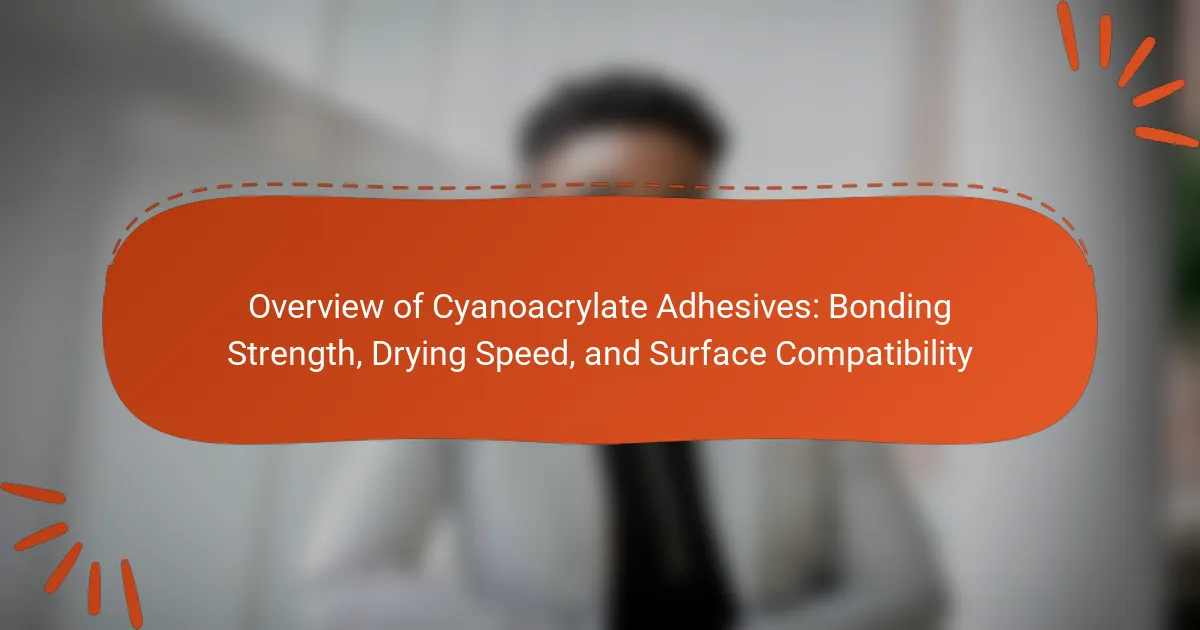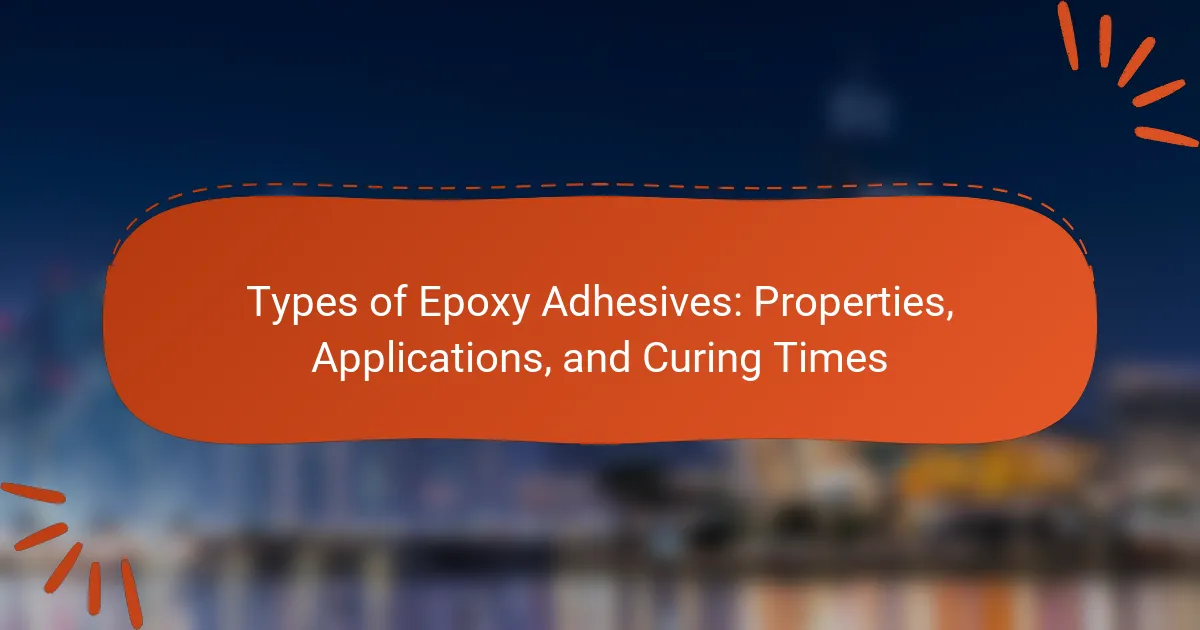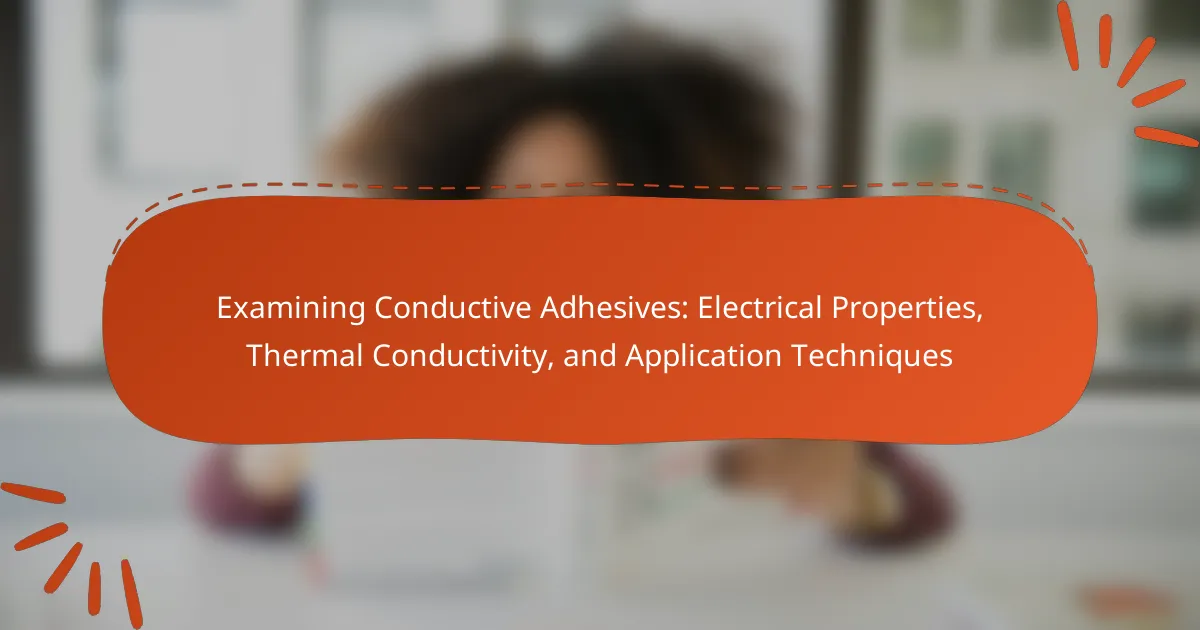Cyanoacrylate adhesives, commonly referred to as super glue, are fast-acting and strong adhesives known for their ability to bond quickly to a variety of surfaces such as metal, plastic, and wood. This article provides an overview of the key characteristics of cyanoacrylate adhesives, focusing on essential aspects such as bonding strength, drying speed, and surface compatibility. High bonding strength is crucial for effective adhesion, allowing for durable connections in immediate load-bearing applications. Additionally, the rapid drying speed enhances efficiency in repairs and manufacturing, while proper surface preparation significantly influences adhesion quality. Understanding these factors is vital for optimizing the use of cyanoacrylate adhesives in both household and industrial settings.

What are Cyanoacrylate Adhesives?
Cyanoacrylate adhesives are fast-acting, strong adhesives commonly known as super glue. They bond quickly to a variety of surfaces, including metal, plastic, and wood. These adhesives work through a process called anionic polymerization, which occurs when moisture is present. The bond forms rapidly, often within seconds, making them ideal for quick repairs. Cyanoacrylate adhesives are characterized by their excellent bonding strength and resistance to heat and chemicals. Their versatility makes them popular in both household and industrial applications.
How do Cyanoacrylate Adhesives function?
Cyanoacrylate adhesives function through anionic polymerization. When exposed to moisture, the cyanoacrylate monomers rapidly react and form long polymer chains. This reaction occurs within seconds, resulting in a strong bond. The presence of hydroxyl ions from moisture initiates the polymerization process. These adhesives are effective on various surfaces, including plastics, metals, and ceramics. Their quick curing time is a significant advantage in many applications. Studies show that cyanoacrylate adhesives achieve full strength within 24 hours under optimal conditions.
What chemical reactions occur during the bonding process?
During the bonding process of cyanoacrylate adhesives, polymerization reactions occur. These reactions involve the rapid curing of cyanoacrylate monomers into long polymer chains. When exposed to moisture, the cyanoacrylate molecules react to form a strong bond. This reaction is initiated by the presence of hydroxyl ions from water. The polymerization process can occur within seconds to minutes, depending on environmental conditions. The resulting bond is characterized by high tensile strength and durability. Studies show that cyanoacrylate bonds can reach full strength in a matter of hours. This efficiency is one reason for their widespread use in various applications.
What are the key components of Cyanoacrylate Adhesives?
The key components of cyanoacrylate adhesives are cyanoacrylate monomers, stabilizers, and solvents. Cyanoacrylate monomers are the primary bonding agents. They polymerize rapidly in the presence of moisture to form strong bonds. Stabilizers are included to enhance shelf life and prevent premature polymerization. Solvents may be used to adjust viscosity for application purposes. These components work together to ensure effective adhesion on various surfaces.
What are the primary advantages of using Cyanoacrylate Adhesives?
The primary advantages of using cyanoacrylate adhesives are their rapid bonding strength, versatility, and ease of use. Cyanoacrylate adhesives bond quickly, often within seconds, making them ideal for time-sensitive applications. They adhere well to a variety of surfaces, including plastics, metals, and ceramics. This versatility allows for their use in diverse industries, from manufacturing to medical applications. Additionally, cyanoacrylate adhesives are user-friendly, requiring minimal preparation and no mixing. Their strong bond strength is due to the formation of a polymer when exposed to moisture. This characteristic makes them suitable for both indoor and outdoor use. Overall, cyanoacrylate adhesives provide efficient, reliable solutions for many bonding needs.
How does bonding strength compare to other adhesives?
Cyanoacrylate adhesives have a bonding strength that is significantly higher than many other adhesives. They can achieve bond strengths of up to 3,000 psi, making them suitable for a variety of materials. In comparison, traditional white glue typically has a bond strength of around 200-300 psi. Epoxy adhesives can reach similar or higher strengths, often exceeding 4,000 psi, but they require longer curing times. Cyanoacrylate adhesives cure quickly, often within seconds, while other adhesives may take hours or days to reach full strength. This rapid bonding capability, combined with high strength, makes cyanoacrylate adhesives a preferred choice for quick repairs and applications requiring immediate adhesion.
What applications benefit from the rapid drying speed?
Applications that benefit from rapid drying speed include medical device assembly, automotive repairs, and electronics manufacturing. In medical device assembly, quick drying ensures efficient production and reduces contamination risks. Automotive repairs require fast-setting adhesives for timely vehicle repairs, minimizing downtime. Electronics manufacturing benefits from rapid bonding to enhance production speed and efficiency. These applications rely on cyanoacrylate adhesives for their quick curing properties, which facilitate immediate use and effectiveness in various settings.
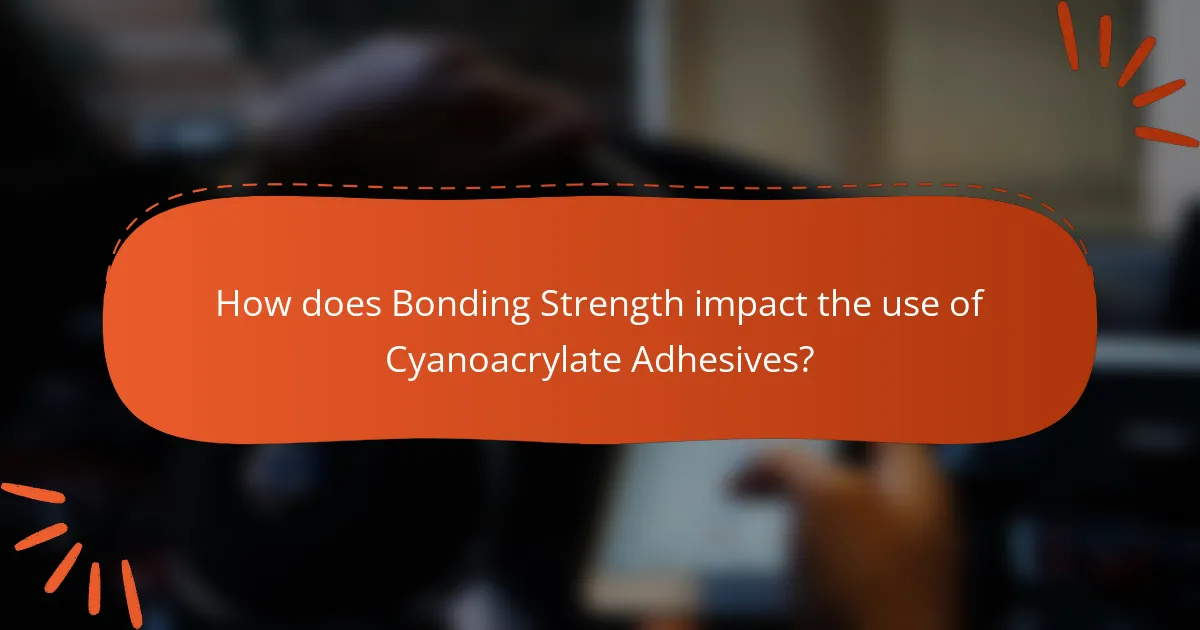
How does Bonding Strength impact the use of Cyanoacrylate Adhesives?
Bonding strength is crucial for the effectiveness of cyanoacrylate adhesives. High bonding strength allows these adhesives to create strong, durable bonds quickly. This is essential in applications requiring immediate load-bearing capabilities. Cyanoacrylate adhesives typically achieve bonding strengths of 20 to 30 MPa on various substrates. The bonding strength is influenced by surface preparation and material compatibility. Properly cleaned surfaces enhance adhesion and increase bond longevity. Additionally, bonding strength determines the types of materials that can be effectively joined. For example, cyanoacrylate adhesives perform well on plastics, metals, and ceramics. Inadequate bonding strength can lead to premature failure in applications.
What factors influence the bonding strength of Cyanoacrylate Adhesives?
The bonding strength of cyanoacrylate adhesives is influenced by surface cleanliness, moisture presence, and material compatibility. Clean surfaces ensure better adhesion by allowing the adhesive to form stronger molecular bonds. Moisture can initiate the curing process, enhancing bond strength. Additionally, compatibility between the adhesive and the substrate material affects how well the adhesive can bond. For example, cyanoacrylate works well with plastics and metals but may struggle with oily or porous surfaces. Temperature also plays a role; higher temperatures can accelerate curing but may weaken the bond if excessive. These factors collectively determine the effectiveness of cyanoacrylate adhesives in various applications.
How do surface materials affect bonding strength?
Surface materials significantly influence bonding strength in cyanoacrylate adhesives. Different materials exhibit varying surface energies, which affects adhesive wetting and [censured]. High surface energy materials, like metals and glass, promote stronger bonds due to better adhesion. Conversely, low surface energy materials, such as plastics, may lead to weaker bonds. Surface roughness also plays a critical role; rougher surfaces increase the contact area, enhancing mechanical interlocking. Research indicates that the optimal bonding strength occurs when the adhesive fully wets the surface. Specifically, studies show that cyanoacrylate bonds on treated surfaces outperform those on untreated surfaces.
What role does the adhesive’s formulation play in strength?
The adhesive’s formulation significantly influences its bonding strength. Different formulations contain varying types and amounts of monomers. These monomers affect the polymerization process when the adhesive cures. A higher concentration of cyanoacrylate leads to stronger bonds due to increased cross-linking. Additionally, the presence of additives can enhance properties like flexibility and temperature resistance. Research indicates that specific formulations can improve adhesion on challenging surfaces. For instance, formulations with rubber additives have shown increased toughness and impact resistance. Thus, the formulation directly correlates with the adhesive’s overall performance and strength.
Why is understanding bonding strength important for specific applications?
Understanding bonding strength is crucial for ensuring the effectiveness of cyanoacrylate adhesives in various applications. Different materials require specific bonding strengths to achieve optimal adhesion. For example, bonding strength impacts the durability of joints in both structural and non-structural applications.
In industries like automotive and aerospace, high bonding strength is essential for safety and performance. In medical applications, the adhesive must bond effectively to biological tissues without causing harm. The appropriate bonding strength also influences the adhesive’s resistance to environmental factors like moisture and temperature.
Research indicates that cyanoacrylate adhesives can achieve tensile strengths exceeding 3,000 psi, making them suitable for demanding applications. Understanding these strengths allows manufacturers to select the right adhesive for their specific needs, ensuring reliability and longevity.
In which industries is bonding strength a critical factor?
Bonding strength is critical in industries such as automotive, aerospace, electronics, and construction. In the automotive industry, strong bonds are essential for assembling components and ensuring safety. Aerospace applications require high bonding strength to withstand extreme conditions. The electronics industry relies on strong adhesives for circuit board assembly and component attachment. In construction, bonding strength is vital for materials like wood, metal, and plastics to ensure structural integrity. These industries often utilize cyanoacrylate adhesives due to their rapid curing and high strength properties.
What are the consequences of inadequate bonding strength?
Inadequate bonding strength can lead to joint failure in applications using cyanoacrylate adhesives. This failure may result in separation of bonded surfaces. It can compromise the structural integrity of products. Inadequate bonding can also lead to reduced durability and lifespan of the bonded assembly. Factors contributing to this issue include surface contamination and improper curing conditions. Studies show that insufficient bonding strength can result in a significant decrease in load-bearing capacity. For example, a study published in the Journal of Adhesion Science and Technology indicates that inadequate bonding can reduce shear strength by over 50%. Thus, ensuring proper bonding strength is crucial for effective adhesion performance.
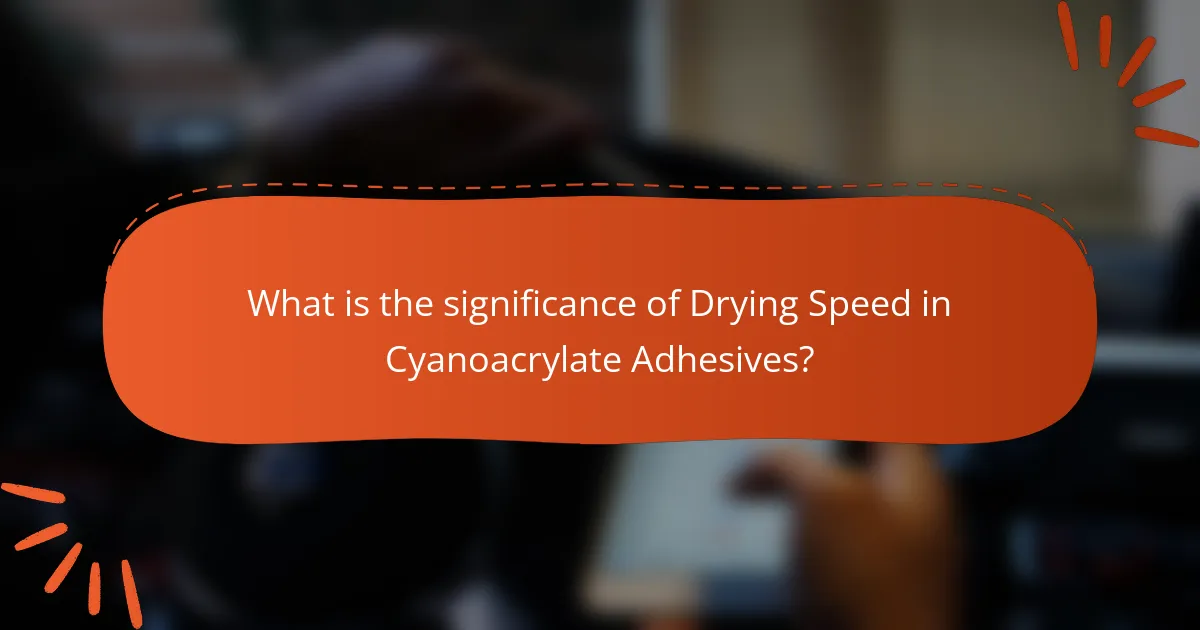
What is the significance of Drying Speed in Cyanoacrylate Adhesives?
Drying speed in cyanoacrylate adhesives is significant because it directly affects the efficiency and effectiveness of bonding. Fast drying allows for quick assembly and reduces the waiting time for parts to cure. This is particularly beneficial in time-sensitive applications such as repairs and manufacturing. The rapid polymerization of cyanoacrylate adhesives ensures strong initial bonds, which can be crucial for structural integrity. Studies show that cyanoacrylate adhesives can achieve bond strength in seconds due to their quick curing nature. This characteristic makes them ideal for use in various industries, including automotive and medical fields.
How does drying speed vary among different types of Cyanoacrylate Adhesives?
Drying speed varies significantly among different types of cyanoacrylate adhesives. General-purpose cyanoacrylate adhesives typically dry within 10 to 30 seconds. Fast-curing variants can set in as little as 5 seconds. Specialty adhesives, like those formulated for porous materials, may take longer due to absorption. The presence of moisture can accelerate the drying process, as cyanoacrylate adhesives cure through a reaction with water. In contrast, low-humidity environments can slow drying times. The specific formulation and intended use of each adhesive type influence the overall drying speed.
What are the typical drying times for various formulations?
Typical drying times for cyanoacrylate adhesives vary based on formulation. Generally, these adhesives can dry in as little as 10 to 30 seconds. Full curing may take anywhere from 24 hours to several days, depending on conditions. Factors influencing drying times include humidity, temperature, and surface materials. For instance, a low-viscosity formulation dries faster than a thicker one. Additionally, specific brands may have unique drying characteristics. Always refer to the manufacturer’s guidelines for precise drying times.
How does temperature and humidity affect drying speed?
Temperature and humidity significantly influence drying speed. Higher temperatures typically accelerate the drying process. This occurs because elevated temperatures increase the rate of evaporation of solvents. Conversely, high humidity levels can slow down drying. Moisture in the air reduces the evaporation rate, leading to longer drying times. Research indicates that cyanoacrylate adhesives dry faster in low humidity and high-temperature conditions. For instance, a study by K. K. Hwang et al. in the “Journal of Adhesion Science and Technology” demonstrated that optimal drying conditions enhance bond strength and speed.
What practical implications does drying speed have for users?
Drying speed of cyanoacrylate adhesives significantly affects user experience. Faster drying speeds allow for quicker project completion. Users can bond materials and move on to the next task without long wait times. This efficiency is particularly beneficial in production and assembly environments. Quick-drying adhesives enhance productivity by reducing downtime. However, rapid drying can also lead to handling challenges. Users may find it difficult to adjust bonded materials before the adhesive sets. Understanding drying speed helps users select the right adhesive for their specific needs. Overall, drying speed directly influences workflow efficiency and project outcomes.
How can users optimize the application process based on drying speed?
Users can optimize the application process of cyanoacrylate adhesives by controlling environmental factors. Maintaining low humidity levels accelerates drying speed. A temperature range of 20-25°C enhances the curing process. Applying thinner layers of adhesive reduces drying time significantly. Additionally, using accelerators can speed up the bonding process. Surface preparation, such as cleaning and roughening, improves adhesion and drying efficiency. These methods ensure a stronger bond in a shorter time frame.
What are common mistakes to avoid related to drying speed?
Common mistakes to avoid related to drying speed include applying too much adhesive. Excess adhesive can lead to longer drying times. Another mistake is using the adhesive in humid conditions. High humidity can slow down the curing process. Additionally, not allowing adequate air circulation can hinder drying speed. Proper airflow helps the adhesive set more quickly. Lastly, ignoring the manufacturer’s instructions can result in improper application. Following specific guidelines ensures optimal drying time.
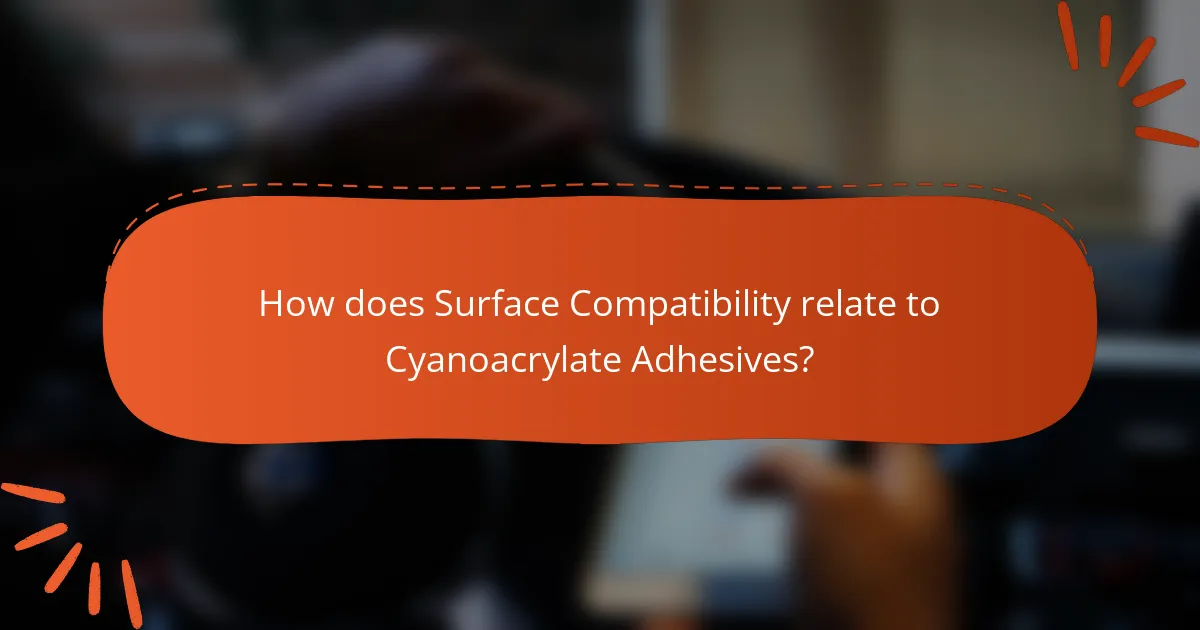
How does Surface Compatibility relate to Cyanoacrylate Adhesives?
Surface compatibility is crucial for the effectiveness of cyanoacrylate adhesives. These adhesives bond best with surfaces that are clean, dry, and free of contaminants. The chemical structure of cyanoacrylate allows it to polymerize rapidly upon contact with moisture, which is often present on surfaces. This means that the adhesive requires a compatible surface to initiate the bonding process efficiently. For instance, cyanoacrylate works effectively on materials like metal, rubber, and plastics when they are prepared correctly. Conversely, surfaces that are oily or heavily textured can hinder adhesion. Studies have shown that surface preparation significantly influences the bond strength of cyanoacrylate adhesives. Proper surface compatibility ensures optimal adhesion and durability of the bond.
What surfaces are compatible with Cyanoacrylate Adhesives?
Cyanoacrylate adhesives are compatible with a variety of surfaces. They bond effectively to materials such as plastics, rubber, metal, glass, and ceramics. These adhesives work well on porous surfaces like wood and leather. The bond strength can vary depending on the specific type of plastic or material. For example, cyanoacrylate adheres best to ABS and PVC plastics. It is less effective on polyethylene and polypropylene without surface treatment. The fast curing time enhances their utility across these materials. This versatility makes cyanoacrylate adhesives popular in various applications.
How do different materials interact with Cyanoacrylate Adhesives?
Different materials interact with cyanoacrylate adhesives based on their surface energy and porosity. High-energy surfaces, such as metals and glass, bond effectively due to strong surface attraction. Low-energy surfaces, like polyethylene and polypropylene, exhibit weak adhesion, often requiring surface treatment. Porous materials, such as wood, absorb the adhesive, leading to a stronger bond as it penetrates. In contrast, non-porous materials may require a thin layer for optimal adhesion. The adhesive cures quickly upon contact with moisture, which is present in many materials. This rapid curing enhances bond strength across various substrates. Testing shows that cyanoacrylate achieves maximum strength within 24 hours on most surfaces.
What surface preparations enhance adhesion?
Surface preparations that enhance adhesion include cleaning, roughening, and priming. Cleaning removes contaminants like dust, grease, and moisture. This is crucial as contaminants can weaken the bond. Roughening the surface increases the area for adhesion. Techniques like sanding or abrasive blasting are effective. Priming can create a more suitable surface for bonding. Primers can improve chemical compatibility with cyanoacrylate adhesives. These preparations ensure a stronger and more reliable bond.
What challenges arise with surface compatibility?
Surface compatibility challenges with cyanoacrylate adhesives include variations in surface energy and material porosity. Different substrates can have distinct surface characteristics that affect adhesion. Low surface energy materials, like certain plastics, may resist bonding effectively. Porous surfaces can absorb the adhesive, leading to weaker bonds. Contaminants on surfaces, such as oils or dust, can also hinder adhesion. Temperature and humidity variations can impact the curing process and bond strength. Additionally, surface treatments or coatings may alter compatibility, complicating the bonding process.
How can users identify incompatible surfaces?
Users can identify incompatible surfaces by checking material compatibility charts for cyanoacrylate adhesives. These charts list materials that do not bond well with cyanoacrylate. Common incompatible surfaces include polyethylene, polypropylene, and Teflon. Testing a small area can also help determine adhesion effectiveness. Additionally, users should note that surfaces with high oil or moisture content may hinder bonding. Understanding the chemical properties of both the adhesive and the surface is crucial. For instance, cyanoacrylate works best on porous materials. Recognizing these factors ensures effective adhesion and prevents failures.
What are the best practices for achieving optimal adhesion on challenging surfaces?
To achieve optimal adhesion on challenging surfaces, proper surface preparation is essential. Cleaning the surface removes contaminants that can hinder bonding. Use solvents like isopropyl alcohol to ensure the surface is free of oils and dust. Roughening the surface can also enhance adhesion by increasing the contact area. Applying a primer specifically designed for cyanoacrylate adhesives can improve bond strength. Ensure that the adhesive is applied in a thin, even layer for effective bonding. Additionally, maintaining appropriate temperature and humidity levels during application can significantly impact adhesion. Research shows that cyanoacrylate adhesives bond effectively to a variety of surfaces when these practices are followed.
What tips should users follow for effective use of Cyanoacrylate Adhesives?
Users should ensure surfaces are clean and dry before applying cyanoacrylate adhesives. Contaminants can weaken the bond. Apply a small amount of adhesive to one surface only. Excess adhesive can slow curing and weaken the bond. Hold the surfaces together firmly for at least 10 to 30 seconds. This pressure helps achieve optimal adhesion. Avoid using cyanoacrylate on porous materials without a primer. Porous surfaces can absorb the adhesive, reducing effectiveness. Store cyanoacrylate adhesives in a cool, dry place to prolong shelf life. Proper storage prevents premature curing. Use gloves to avoid skin contact, as cyanoacrylate bonds skin quickly. Following these tips enhances the effectiveness of cyanoacrylate adhesives.
What safety precautions are essential when using Cyanoacrylate Adhesives?
Wear protective gloves when using cyanoacrylate adhesives. This prevents skin contact with the adhesive. Use safety goggles to protect your eyes from splashes. Ensure adequate ventilation in the workspace to avoid inhaling fumes. Store cyanoacrylate adhesives in a cool, dry place away from children and pets. Follow the manufacturer’s instructions for safe usage. Dispose of any unused adhesive according to local regulations. These precautions minimize health risks associated with cyanoacrylate adhesives.
How can users troubleshoot common issues with Cyanoacrylate Adhesives?
Users can troubleshoot common issues with cyanoacrylate adhesives by identifying the specific problem. For instance, if the adhesive does not bond properly, ensure that surfaces are clean and dry. Contaminants like oil or dust can prevent adhesion. If the adhesive cures too slowly, check the humidity and temperature of the environment. Higher humidity can accelerate curing. If the bond is brittle, it may be due to improper surface compatibility. Different materials require specific formulations of cyanoacrylate. Users should also avoid using excess adhesive, as this can create weak bonds. If the adhesive is clogged, clean the nozzle with acetone to restore functionality. Following these steps can help resolve common issues effectively.
Cyanoacrylate adhesives, commonly known as super glue, are fast-acting bonding agents characterized by their strong adhesion to various surfaces such as metal, plastic, and wood. This article provides a comprehensive overview of cyanoacrylate adhesives, focusing on their bonding strength, drying speed, and surface compatibility. Key components, chemical reactions, and advantages of these adhesives are discussed, along with factors influencing their performance and practical applications across various industries. Understanding these elements is crucial for effective use and troubleshooting of cyanoacrylate adhesives in both household and industrial settings.
